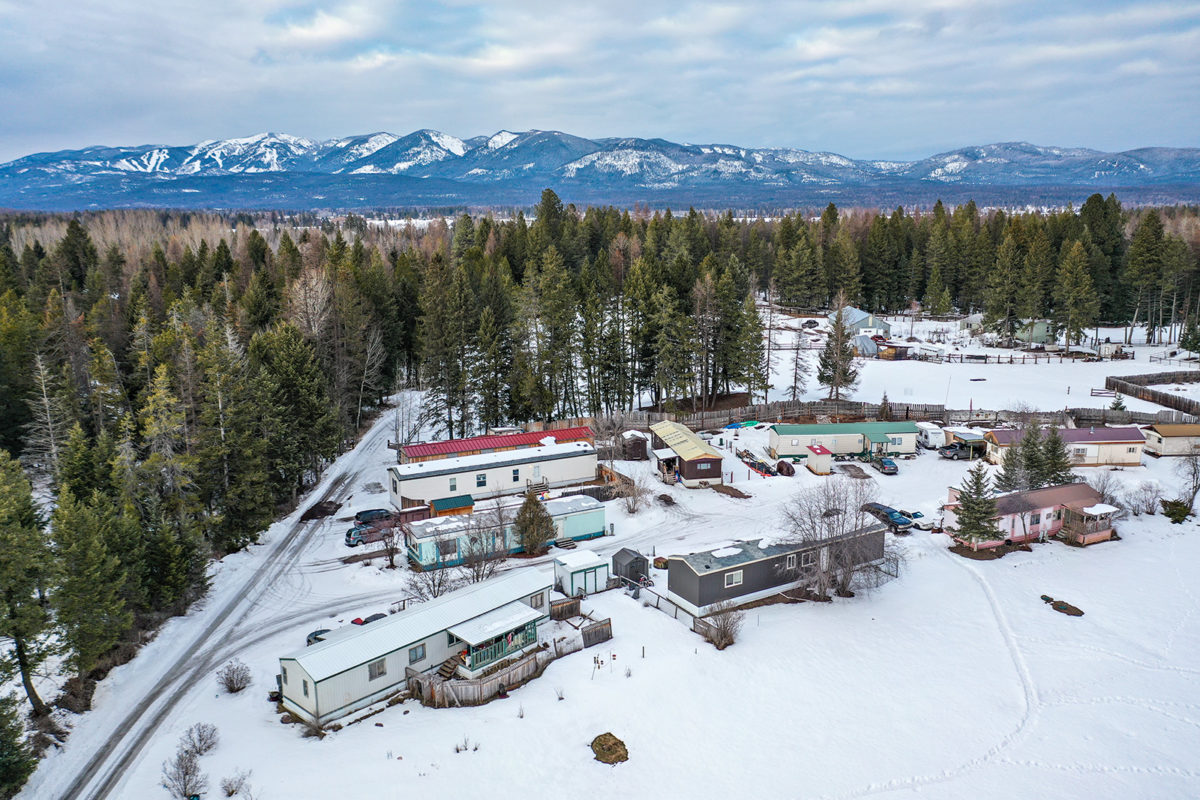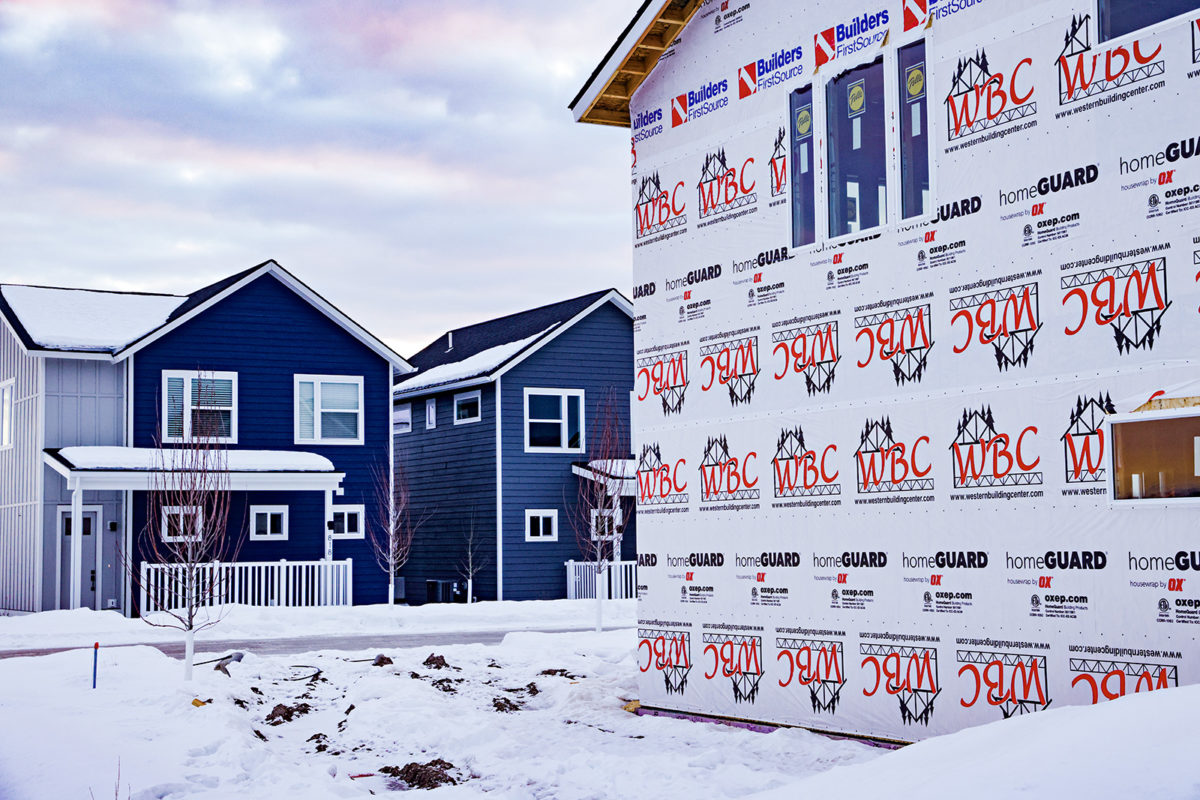Solving the Housing Crisis
As housing demand continues to outpace supply, nonprofit agencies are using creative financing and city officials are approving record multi-family housing developments
By Maggie Dresser
Last October, 28-year-old Devynn Fetter came home to her single-wide trailer in Columbia Falls to find a pamphlet on her door that said the owners of the manufactured-home park were selling and they were hoping to close by Christmas.
After an initial panic, Fetter quickly learned that the pamphlet was from NeighborWorks Montana, a local nonprofit that helps homeowners finance manufactured-home parks through a Resident Owned Community (ROC) program. Officials with the program were offering to guide the residents through the process, which would allow them to form a cooperative and an incorporated community that they would manage.
“Initially, it was a little bit nerve wracking,” Fetter said. “Where else can you go to afford what we pay here? We all own homes but we rent the lots and I thought, ‘Oh my gosh, what if we decide to not incorporate? How is that going to affect us? What are we going to do?”
Fetter soon became the interim board president and started knocking on doors and informing her neighbors, many who are elderly, about the process. Twenty seven out of the 30 homeowners decided to incorporate and paid the one-time membership fee of $100 and the neighborhood became the Hideaway Community after it closed in January.
Now that the Hideaway is resident-owned, the homeowners don’t have to worry about a new owner buying the park and hiking up lot fees or kicking them out.
“There are many benefits of resident ownership,” said Danielle Maiden, a ROC program manager at NeighborWorks. “The residents review and approve a budget every year and they can identify capital improvements and budget for those … They also want to keep the rent affordable, and they are able to fluctuate those budgets. They know what’s coming down the pike for the next 12 months and they also know they will not be evicted without cause. Nobody’s going to sell the park or redevelop it. There’s just a lot of housing stability.”
Maiden finalized a contract with the park’s previous owners last year after negotiating the sale for the residents at market value. To benefit the seller, they often work directly with the owner to avoid realtor fees and their Montana state capital gains are forgiven.
“Many park owners have excellent relationships with the residents,” Maiden said. “A lot of families have created these communities and they appreciate their residences … Yes, there are some financial pieces, but they can get the same amount that they would from an investor by selling to residents.”

NeighborWorks is one of a handful of nonprofits guiding individuals and families in the Flathead Valley through Montana’s housing crisis, where the median sales price in Flathead County in January 2022 was $520,000 and $632,000 in Whitefish, according to MLS data.
In addition to ROCs, the nonprofit provides homeownership loans where borrowers can put as little as 1% down. They also provide Community Development Financial Institution (CDFI) loans, which can leverage grant funds, provide financing for affordable housing developers and housing education through HUD-approved agencies.
The Northwest Montana Community Land Trust is another affiliate with NeighborWorks, which purchases properties to maintain in trust as permanent affordable housing options. Similar to the ROC concept, buyers purchase the home itself, below market rate, while the land trust maintains ownership of the land and homeowners pay an affordable monthly ground lease.
But as local nonprofits are helping create an affordable path to homeownership on a small scale, it doesn’t change the lack of housing stock in the Flathead Valley. As the demand continues to rise, supply simply cannot keep up.
In the past year, the City of Kalispell has approved 2,209 multifamily units and 900 single family town homes.
Once developments are approved, it takes anywhere from months to years for projects to break ground and many units that are nearing the end of construction were approved before the pandemic began.
The Landings, a 322-unit apartment complex off Two Mile Drive and a separate 144-unit apartment complex on Meridian Court were both approved pre-COVID and only recently became move-in ready, according to city planners.
While most of these units will be listed at market rate and will accommodate workforce housing, the Kalispell City Council recently approved a 138-unit income-based multifamily development on North Meridian Road called Junegrass Place, which the Montana Board of Housing awarded $4.78 million in federal housing tax credits and will meet Section 8 voucher standards.
In 2020, Kalispell approved a 36-unit affordable senior development called Creekside Commons, which was also awarded tax credits.
“Housing is a national issue, it’s not just a Kalispell issue,” Kalispell Development Services Director Jarod Nygren said. “It stems from a lack of housing units … The only way you’re going to get out of this is by building more units and that’s the policy direction that our council is headed. It’s supply.”
In 2020, the council voted to lower impact fees for developers to remove cost barriers, and while it drew criticism because it spiked water and sewer rates for residents, it helped attract more multifamily housing projects.
“If you look at the numbers from our past reports when the impact fee was lowered, we are now number one in the state for multifamily units,” Nygren said. “We had 150 building permits issued in 2020 and 650 in 2021. Those are all under construction as we speak on top of the 2,209 that are planned.”
But even after projects are approved and building permits are issued, developers are facing numerous challenges that create a difficult environment to keep housing affordable.
In 2018, the Whitefish City Council approved the Trail View subdivision, which is affiliated with the Whitefish Housing Authority, on the eastern edge of the city with the hope of building entirely deed-restricted, single-family homes on 58 lots. Council set conditions of 150% of the area median income.
When developer Jerry Dunker first began the project, he listed prices ranging from $290,000 to $310,000 in the roughly 1,300 square-foot homes. But as supply chains disrupt timelines and materials and labor costs continue to rise, prices are now upwards of $350,000 to $370,000.

“We’re definitely selling them less than cost, which isn’t sustainable,” Dunker said.
Dunker has sold half of the homes at Trail View and he was hoping to finish construction by the end of the year, but delays have pushed back the end date to at least 2024.
To earn back some of his losses, Dunker is now proposing to the Whitefish City Council to pull 10 homes out of the deed restriction for sale on the free market.
“If we don’t pull 10, the other 29 units will have to be over $500,000,” Dunker said. “We don’t have a choice.”
Dunker said he’s been approached by buyers who are interested in donating the homes back to the Whitefish Housing Authority to keep them affordable, but nothing is set in stone.
“I think the future of projects like this is they will be a mix of free market and deed restricted,” Dunker said. “Using profits from free market and using those for the shortfalls of deed restricted. We went 100% from the start and in hindsight, we should have done 10 or 20.”
For Fetter, she’s thankful that NeighborWorks stepped in to help save some of the only low-income housing available in the Flathead Valley.
While her lot fees rose $100 from $370 after becoming incorporated as an ROC for infrastructure improvements, including septic system upgrades, she’s relieved that her rate likely won’t increase much more in the coming years and she and her neighbors won’t get evicted.
As a full-time environmental health technician for the Flathead City-County Health Department, Fetter works an additional part-time job cleaning homes while she finishes school to earn a bachelor’s degree in health science so she can advance her career.
After living in her home for the last seven years, she can’t imagine how she would be able to find housing if she was kicked out of the manufactured-home park.
“I would be that stereotypical almost-30-year-old going to live in my parents’ basement,” Fetter said. “Honestly, I was really concerned about that and I did not feel like I would have any options to stay in the Flathead. I’m going to school to further my career at the health department, and it would have been all for nothing. I’ve been at this job for almost four years now and I would have had to restart.”